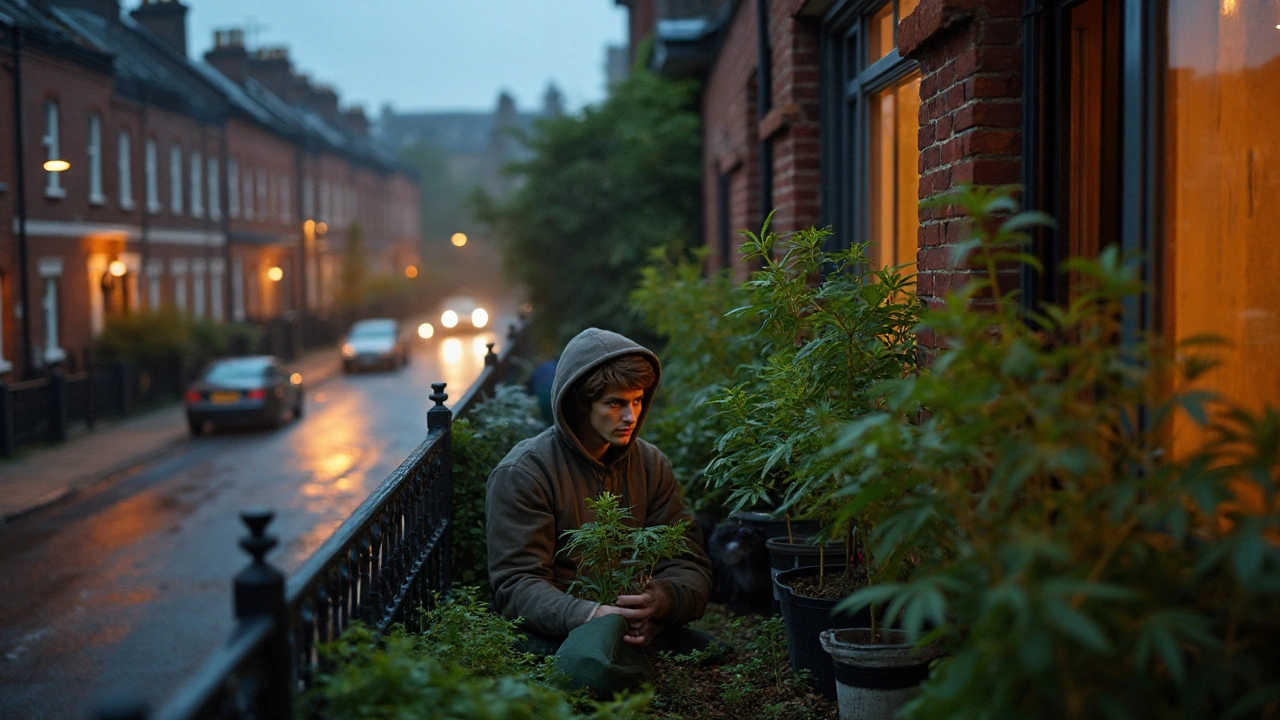Stealth Cannabis Growing: Best Low-Odor Genetics for Discreet Harvests

Why Cannabis Scent Happens and How Genetics Shape It
Ever walked past someone’s house and instantly caught that unmistakable, musky-sweet whiff of blooming cannabis? Yeah, it’s not your imagination. The truth is, cannabis scent is wild; it’s actually one of the plant’s defense strategies. The smell comes down to a group of chemicals called terpenes. Every strain, whether it reeks or is pretty subtle, carries a unique set and amount of terpenes. Some are fruity, some piney, others just scream 'grow op in progress.' For those wanting to fly below the radar, understanding how genetics influence this pungency is the game-changer.
Here’s something most people don’t realize—many low-odor strains weren’t even intentional. Early breeders focused on potency or yield, not stealth. But as legal grey-zones and seed sharing grew, so did the demand for stealthy marijuana. Enter specialized breeding: now geneticists select plants that express fewer aromatic compounds or change their chemical profiles so the average nose can’t place them. Remember, it’s not just about cutting down smell; it’s about changing which terpenes hit your nostrils first. So, if you’re curious why your plant isn’t stinking up the place, look at its family tree and its dominant terpenes—not just your airflow setup.
Want to know a cool fact? The heaviest-smelling terpenes, like myrcene and limonene, dominate commercial strains. On the flip side, stealthy options often lean towards pinene or ocimene, with much less 'skunk.' There’s even ongoing research in Europe comparing terpene volumes in urban-vs.-rural grows to see just how much human activity effects how much smell the plant kicks out. Point is, DNA matters—a lot. And the right genetic pick gets you halfway to a nose-proof harvest.
Best Low-Odor Cannabis Strains and Their Genetic Secrets
Not all weed is equal when it comes to scent. Some strains will leave your entire block sniffing out your hobby, while others barely register unless you’re face-first in a flowering cola. The best stealth options come from deliberate breeding and close attention paid to classic genetics like Northern Lights, Hindu Kush, and some modern auto-flowering hybrids.
If your main concern is minimising aroma, check out genetics like Northern Lights, Blue Mystic, and Swiss Miss. Northern Lights is basically the gold standard—anyone who grew in shared apartments in the 90s and 00s will tell you, she’s as close to invisible as you get without being actually invisible. Blue Mystic follows a similar path, with milder undertones and almost no 'classic weed' funk. Some modern auto-flowering strains, mostly built on ruderalis genetics, show surprisingly low scent in flower, though you’ll want to research—'auto' doesn’t always mean 'discreet.'
Another interesting option is C99 (Cinderella 99), famous both for a zesty pineapple vibe and subtle aroma. Hindu Kush, while not completely odorless, gives more of a refreshing earthy incense than nose-burning 'skunk.' The secret here? Each of these strains has fewer or differently balanced terpenes, so you evade that notorious weed stench. Breeders are also pushing hybrid varieties, crossing these genetics with other desirable traits, so discreet doesn’t mean weak or bland anymore.
Some growers are going so far as to track terpene outputs with mini-lab kits or smartphone monitors, selecting mothers that barely pass the human scent test. If you want a deeper dive into low-odor marijuana genetics, grab resources that list not only strain names but also how growers rate the nose-factor at each stage of the grow. Don’t just take seedbank hype as gospel—grow reviews matter.

Real-World Tactics: Growing Methods to Dodge Detection
If you’re sweating scent, genetics does the heavy lifting, but how you grow makes a difference, too. Even the stealthiest seed can blow its cover with the wrong environment. So, how do savvy growers in places like apartments, terraces, or tightly packed Aussie suburbs pull it off? First off, airflow is your mate. Using cheap, quiet fans to keep the space ventilated and push the air upwards (not out windows) makes a surprising difference.
Activated carbon filters—think charcoal canisters for grow tents—are another lifesaver. These suck up stray odors before your neighbors have a clue. Don’t overlook the simple power of environmental control, either. Grow tents with solid seals, holding humidity down to the 40%-60% zone, will cut the chemical signature in the air. If you’re in an indoor setup, keeping the temps more stable (not baking hot!) helps with terpene volatility—warmer rooms mean stronger smells, cooler ones keep it subtle.
- Keep your grow area small—don’t try to flower a dozen big sativas in a studio flat.
- Defoliation during late veg and mid flower can reduce the aroma released.
- Some folks use ozone generators or ionizers, but these need a careful setup—improper use can harm plants or health.
- Don’t just mask smells with spray or incense. These only work if you have tiny leaks, not if the whole room reeks.
If you’re venting air outside, consider a “scrubber box”—a big tote with activated carbon fans pulling air in and out. Some even double-tap with two filters in a row. If you’re sharing a place or the landlord is drop-in happy, double-bag all your trimmed flowers, and stash in the freezer. During harvest, quick-dry trimmings outdoors when you can, or use air-tight space bags with desiccant packs. For the tech-obsessed, IoT air monitors will alert you if aroma spikes, so you can take action fast.
Beyond the Plant: Lifestyle Hacks for Growing Discreetly
Low-odor genetics and smart growing techniques get you far, but cultivating in stealth mode is a vibe—every part of your routine counts. Have you ever noticed how the smell follows you, not just the plant? Clothes, hands, gear, even hair, can kick up a whiff if you’re not careful. After every visit to your grow space, change into fresh clothes and wash hands thoroughly. Store all tools away from living areas, preferably in a lidded plastic bin with dryer sheets or sealed sachets.
Avoid drying your weed in living areas—stick to sealed wardrobes or garages where you can rig a filter or exhaust. If you’re curing, invest in jars with quality seals and throw in a humidity control pack; opening lids outdoors or in the car, not the kitchen, keeps scent transfer low. Most folks don’t realize, but grow lights and heated tents put out subtle but telltale scents that some pets and sensitive neighbors will notice before you do. Watch for complaints about 'strange plant smells' and take action before they escalate.
If you go away for the weekend, tuck all gear and plants deep in a locked space—an untended, fragrant crop is riskier than anything. Tech can help: install magnetic door alarms or motion-detection cameras to warn you if someone visits your grow zone when you’re not home. Use a dedicated phone or email for all your cannabis-related shopping and communications; it keeps everything cleaner and less suspicious.
Last tip: Always act like you’re not growing at all. Don’t talk about it, don’t post plant pics online, and for the love of privacy, don’t vent to coworkers about trimming stress. If your routine suggests 'nothing to see here,' your chances of keeping things low-key go up—way up.
Anyone hunting for modern strains with muted odor doesn't have to sacrifice quality. With a blend of clever genetics, smart gear, good habits, and a little local knowledge, you can enjoy homegrown weed without worrying every time a neighbor walks their dog past your window. Stay safe, grow smart, and keep your nose—and the block’s—happy.






Comments
Deb Kovach
July 18, 2025 AT 07:46Hey everyone! This article is such a gem for folks trying to keep their grows under the radar. 🌿✨ I've personally had a lot of success experimenting with low-odor strains like Northern Lights and CBD-rich varieties that don't hit your nose like a freight train. It’s crazy how terpene profiles make all the difference, right?
Also, using activated carbon filters and placing your plants near air purifiers can work wonders for keeping the smell minimal indoors. For those on balconies or shared houses, it’s worth noting that timing your watering and trimming sessions for early mornings helps reduce scent exposure too.
Does anyone else have any special tricks or favorite stealth strains? I’m always eager to learn from fellow cultivators! 😊
Ajay Kumar
July 19, 2025 AT 07:00Totally agree with you about the terpene profiles! It’s interesting how subtle differences in strain genetics literally transform how much scent they release. I live in a pretty dense apartment complex, so discretion is not just about privacy but also respecting neighbors.
One thing I add is using odor neutralizers close to the grow area, like specialized gels that absorb odors without masking them with harsh fragrances. They’re effective without triggering suspicion or allergies.
It would be cool if the article had more info on environmental controls, like humidity and temperature, affecting scent emission. Has anyone tried that approach?
Sarah Pearce
July 20, 2025 AT 06:13idk, i find all these stealth strain things kinda overhyped... i mean, end of the day bud smells no matter what u do right??? especially if there’s neighbors who r nosey, its almost impossible to keep it 100% undetectable lol!!! ???
they mention science and genetics n stuff but honestly ive seen more ppl get caught coz they rely too much on ‘low odor’ strains and dont do the basic smelling precautions. BUT yeh maybe worth a try if u got no choice.
anyone got an honest story about when stealth growing just didnt work? i'm just curious cuz this stuff sounds a bit wishful tbh...
Pramod Hingmang
July 21, 2025 AT 05:27Honestly, I feel like managing the environment is half the battle. The article hints at this but I think growers often overlook how air flow and proper sealing of grow tents contribute to odor control.
The genetics are crucial, but pairing those low-odor strains with well-ventilated setups can create a pretty stealthy operation. Not to mention, smart scheduling of when to enter and handle the plants avoids lingering scents.
Anyone using smart tech for real-time monitoring of humidity & scent levels? That could be the path forward for stealth growers in busy living spaces.
Rebecca Ebstein
July 22, 2025 AT 04:40Oh wow, I’m so happy to see this topic get some love! I’m kinda new to growing but really want to keep it chill and not get into trouble. Reading about the terpene profiles made me realize I was clueless about why some plants smell worse than others.
Also those tips about doing trims early and using carbon filters sound like practical must-tries! 💨🌬️ Shinier happy plants with less suspicion sounds like the dream!
Does anyone else feel a bit overwhelmed by info sometimes? I think breaking it down to simple steps like this article helps a lot.
Richa Ajrekar
July 23, 2025 AT 03:53First off, cant stand how some people spell 'cannabis' wrong in articles like this. Its basic b*tch knowledge! 🙄 Anyways, i feel like focusing too much on 'low-odor genetics' is just masking the real issue.
Grow responsibly and learn how to manage your space rather than looking for some ‘magic strain’ to hide your grow. In India and many places, such lazy mentality gets people busted more than good planning.
What about good ventilation practice and regular maintenance? That should be stressed way more than this 'terpene profile' fad people are blindly chasing.
Benjamin Hamel
July 24, 2025 AT 03:06Honestly, the obsession with 'stealth' strains is a bit theatrical if you ask me. Long story short: cannabis smells. Period. Genetics or no genetics, you can’t escape that natural pungency without some amateurish workaround.
The article’s focus on 'science' and 'savvy tactics' almost feels redundant, given the blatant obviousness that a real grower just handles the smell proactively with technology, not wishful genetics.
I mean, sure, disclaimer: genetics influence the aroma but the low-odor marketing is often exaggerated. Just my two cents.
Christian James Wood
July 25, 2025 AT 02:20Wow, reading some of the critiques here is amusing, but seriously? People expect zero odor from any cannabis grow? It’s hilarious how some folks act like the smell is a boogeyman 👃😂.
Respectfully, if you’re depending only on genetics for stealth, you’re setting yourself up for mediocrity at best. The best growers blend genetics, environment, and a bit of stealth ninja gear like charcoal filters and scent neutralizers.
Low-odor strains can reduce the risk, but anyone thinking it’s a foolproof solution clearly hasn’t grown enough. This article was spot on in covering a balanced approach.
Roger Cole
July 26, 2025 AT 01:33From a practical standpoint, the best way to stay discreet isn’t just about the strains but also how meticulous you are with your grow environment and daily habits. Regular cleaning, air exchanges, and controlling all possible scent leaks are key.
Also, the mental game is important—being cautious without paranoia keeps you consistent and calm. Overthinking leads to slip-ups, honestly.
Would love to see more detailed guides on integrating tech and genetics for stealth growing, maybe future articles could dive deeper there.
Krishna Garimella
July 27, 2025 AT 00:46This subject is quite fascinating beyond just the practical; it ties into larger notions of privacy, legality, and personal space. Growing cannabis stealthily is almost a modern philosophical challenge about balancing freedom and communal respect.
I appreciate the article’s scientific angle on terpene profiles and genetics since it grounds the discussion in evidence rather than myth. Low-odor genetics are like an example of how nature and human intelligence interplay.
To all stealth growers, stay mindful of your environment and community alongside your plants. Happy growing!
Artie Alex
July 28, 2025 AT 00:00I have to question the whole romanticizing of 'stealth' cannabis growing featured here. Much of what’s touted as low-odor genetics is marketing fluff to boost prices. Genuine discretion is about sophisticated airflow and chemical masking, not relying on some ‘quiet’ strain.
Additionally, the article’s tone tries to cater to rookies, which is fine, but it lacks a critical perspective on potential legal risks and the false sense of security such guides might instill.
Anyone else concerned about overemphasizing genetics and underselling operational security?
Deb Kovach
July 28, 2025 AT 23:13Thanks everyone for such thoughtful input! I see there’s a mix of enthusiasm and skepticism, which is totally valid. Cannabis cultivation isn’t a one-size-fits-all scenario, and stealth indeed demands effort beyond genetics alone.
That said, genetics form the foundation—starting with low-odor plants reduces the baseline scent, allowing other methods like filters and timing to work more effectively rather than fighting a heavy stink monster.
Regarding legal risks, I hope everyone understands this is about responsible growing in permitted environments. For those in stricter areas, discretion is safety. If anyone wants, I can share a few strain recommendations and environmental hacks that worked for me personally! 🌱😊